September, 2018

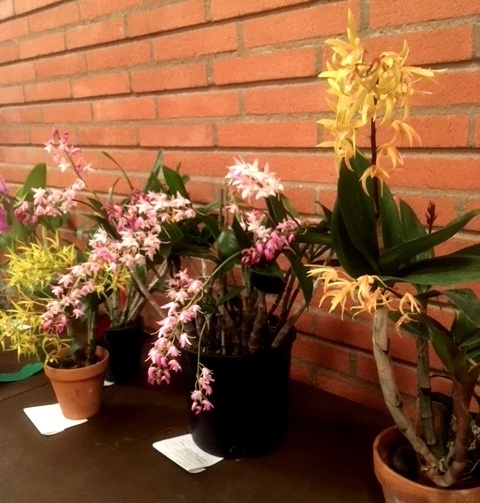
Some "Aussie" Dendrobiums grown by our members
Outdoor Dendrobiums:
Our September, 2018 speaker, Scott McGregor (Pushing Limits — Growing Orchid Species in Coastal Southern California), mentioned that he has had good success growing many Denrobiums outdoors in his shade house, exposed to all the summer heat and winter damp — conditions that decades of orchid cultural tradition tell us will kill the plants, or at least prevent them from flowering. Intrigued, we asked him for some additional recommendations for outdoor Dendrobium and related genera in our area. See his recommendations, below!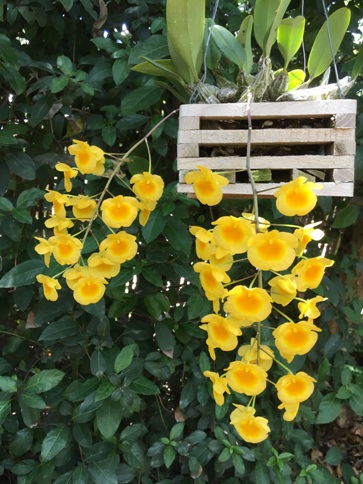
D. aggregatum in web master's jungle
Most of us learned that D. aggregatum (and the smaller D. jenkinsii, see below for its story!) has to be kept bone dry during the winter in order to bloom. But Scott has found (and your web master confirms in his own back yard! — see left) that these species can do just fine if left outside all year long, but without extra water during the winter. Maybe initiating flower spikes in these species has more to do with cooler night temperatures and longer day length, provided they don't sit too long with wet feet.
Here are Scott's recommendations for additional Dendrobiums that have performed well for him outdoors (photos kindly provided by Scott McGregor):
Dendrobiums comprise a very large genus of around 1200 species, with broad geographical and climatic diversity. Many do very well in our Southern California climate. Dendrobium nobile and its many hybrids can be found in your neighborhood grocery store. Australian species D. speciosum, D. kingianum, and their respective hybrids are plentiful in Spring orchid shows. These are easy to grow and are probably already in your collection.
There are many lesser-known and under-appreciated Dendrobium species that also do well in our climate and have a charm of their own. Here are five of my favorites to try—one very easy, three intermediates, and one to challenge more expert growers…
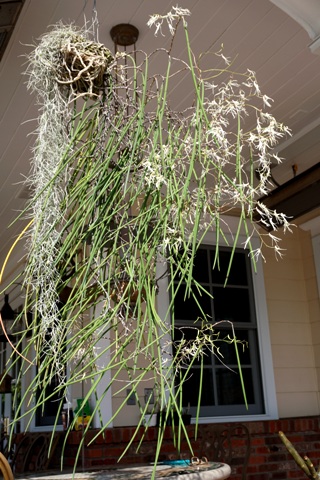
Dockrillia teretifolia

Dockrillia teretifolia (Dendrobium teretifolium). This is an easy Australian species that has long pencil-like “terete” leaves that hang downward. These plants are best mounted or planted in small baskets with a bit of sphagnum and lava rock, so they can drape downward over time as the plant grows. In California, these plants bloom in the Spring with many clusters of fragrant white flowers, sporadically through the summer and then another flush bloom in Autumn. They need little care—give them bright light (larger plants like a few hours of full sun). Water and fertilize them more frequently when actively growing and less so in the winter. They don’t mind summer heat and can handle a light frost.
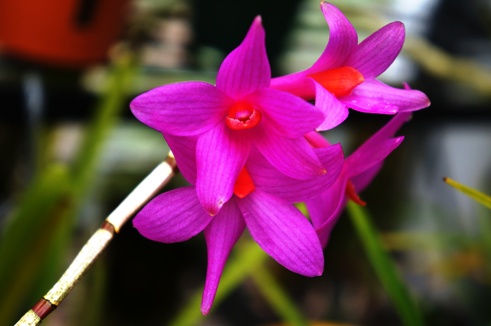
Den. glomeratum (crepidiferum)
Dendrobium glomeratum (also sold as D. crepidiferum or D. sulawesiense) has a fantastical deep magenta crystalline flower with an orange/red lip. Keep moist year-round, give it bright light, and either mount or grow in a small basket. The flowers vary quite a bit in size, form and color, so it is best to buy one you can see in bloom, or with a picture of the flower from the plant you’re buying.
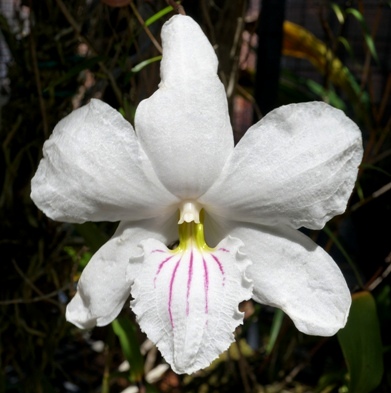
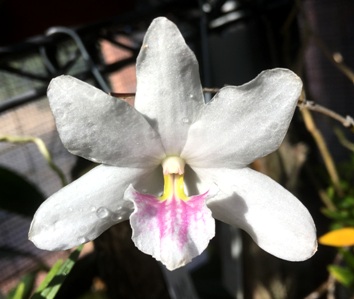
Two forms of Den. papilio
Dendrobium papilio comes from the Philippines and is attractive even when not in bloom with bamboo-like fine, dark-green leaves on wiry thin canes. The fragrant flowers are 3-4” in size and are a sparkling crystalline white with rose markings in the lip. The flowers seem to appear without notice late spring and summer as the buds mature quickly, and wave in the breeze. Grow this one cool and moist, with bright light year-round. A bit tricky to find, but Andy’s Orchids is a good source.
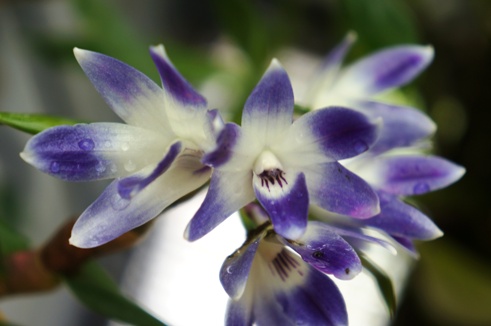
Den. victoria-reginae, the "Blue Dendrobium"
Dendrobium victoria-reginae comes from the mountainous areas in the Philippines, and has pretty, long-lasting violet/blue and white flowers in the summer. Keep it moist all year, shaded, and it enjoys cool nights, so this is one that will do better outside than in a greenhouse and is especially suited for those who live within a few miles of the coast. It flowers on older, leafless canes.
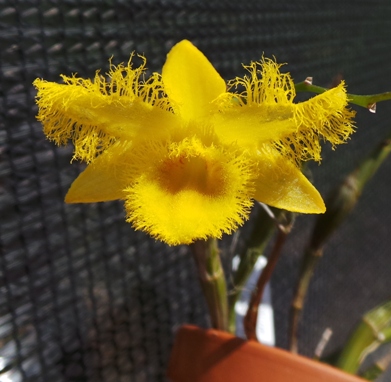
Den. harveyanum
Dendrobium harveyanum comes from Burma, needs a completely dry rest in the winter, and plenty of water, warmth, and bright light in the summer. This one is a bit more challenging than those above, but if grown well will reward you with the Dendrobium equivalent of Rhyncolaelia digbyana—wildly fringed bright yellow flowers. Best mounted or grown in a small pot so the roots can dry out—it doesn’t like to be overpotted.
Hope this inspires you to try one or two new Dendrobium species. Happy growing!
—Scott McGregor
Most of our local orchid nurseries carry Dendrobium species. Andy's Orchids has a particularly large selection. Scott found some of these species on eBay, but he reminds us to pay attention to vendor ratings.
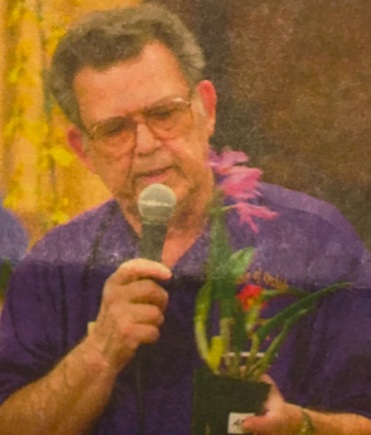
Dr. Plocher presents a plant for auction
Blast from the past: 2002
Janell found a newspaper clipping about the SCOS auction in 2002 (Press-Telegram, November 28, 2002). The scene is familiar: the same tables and chairs in the same meeting room, and a jumble of plants hoping to go home with you! The auctioneer was Dr. Phil Plocher, past president of the society.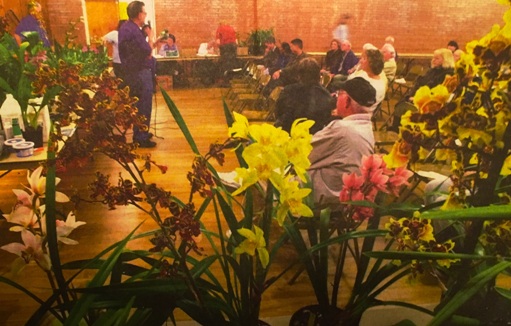
Feeding our orchid hobby
The SCOS auction is our main fundraising activity. Many of the plants are donated by local nurseries. However, the selection often includes divisions of "back yard" plants, no longer commercially available, that have been kept going by dedicated hobby growers. The auction provides an excellent opportunity to obtain some distinctive plants for your collection!
_pl_37_(1839).jpg)
Blast from the past: 1839
Dendrobium jenkinsii has been appreciated for a very long time! "Miss Drake" (Sarah Drake, a well-known botanical artist of the time) published this illustration in Edwards' Botanical Register in 1839! However, at various times this form has been lumped with D. aggregatum, which in turn has also been known as D. lindleyi. Sometimes you will find plants that are definitely the D. jenkinsii form labeled as either aggregatum or lindleyi. The difference when the plants are in bloom is obvious: the form usually known as aggregatum has long, pendant spikes with many flowers, while jenkinsii has short spikes, not particularly pendant, with usually only one or two flowers per spike. The leaves and pseudobulbs of jenkinsii are noticeably smaller as well, if you are able to see the two forms side by side. The description accompanying the plate from 1839 also notes that the pseudobulbs of D. aggregatum consist of several internodes, while those of D. jenkinsii are formed from a single internode. This distinction should be easily visible from the way the dried sheaths are attached along the length of the pseudobulbs, but the descriptions of the time were based on a very small number of plants collected from the wild, and, therefore, the differences might not be as definitive as first thought.Unfortunately for our plant labels and sane communication, the name Dendrobium aggregatum got tangled up in some taxonomic errors or missteps, with the result that the "official" name is now held to be Dendrobium lindleyi, and the smaller form jenkinsii is frequently considered to be only a variety of lindleyi, called Dendrobium lindleyi var. jenkinsii. However, aggregatum and jenkinsii are so well established in the orchid trade, that most of us cling to the old, familiar names. Pick a name and stick with it, but be aware that you may find any of these names in nursery catalogues!
Do the two forms occur together in nature? Or do they have distinct distributions, habitats, or pollinators, suggesting that they might really be distinct species? Your web master would be happy to undertake a fact-finding mission, if anyone would care to fund an expedition into the mountains of South-east Asia.